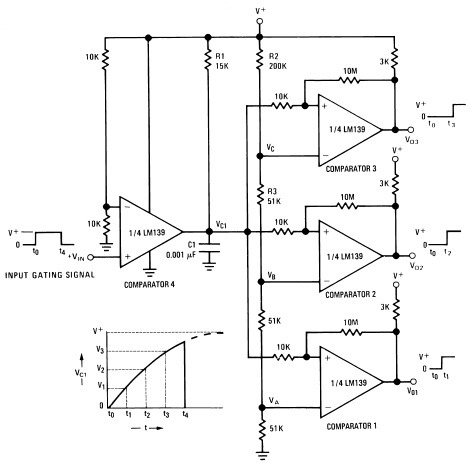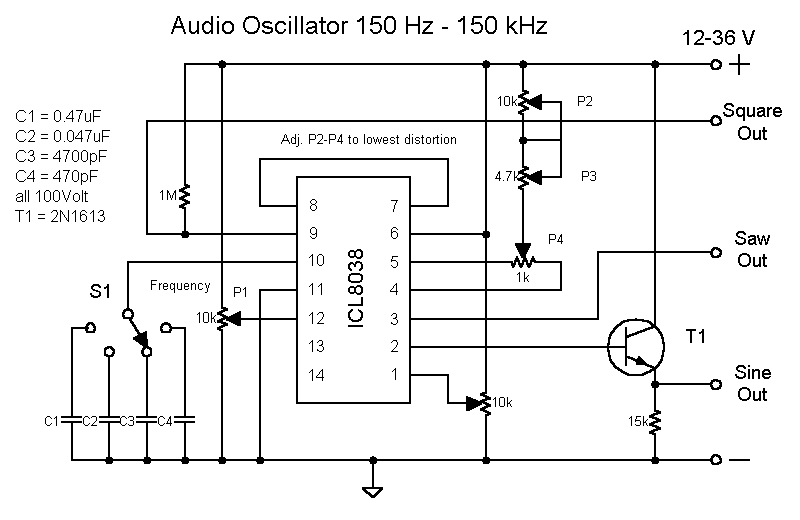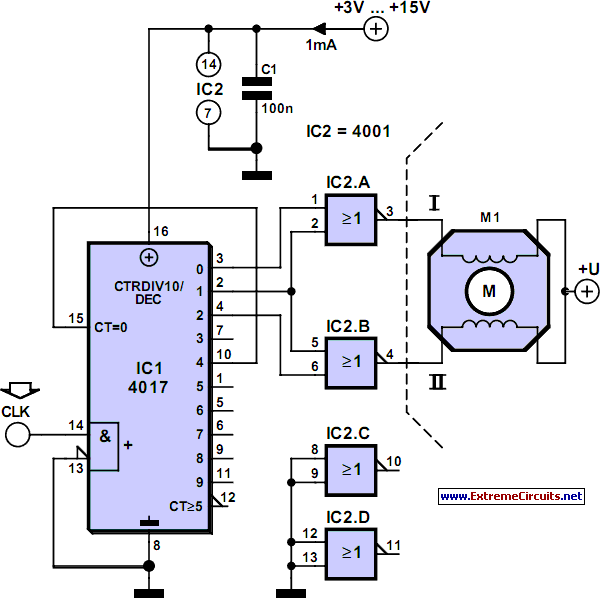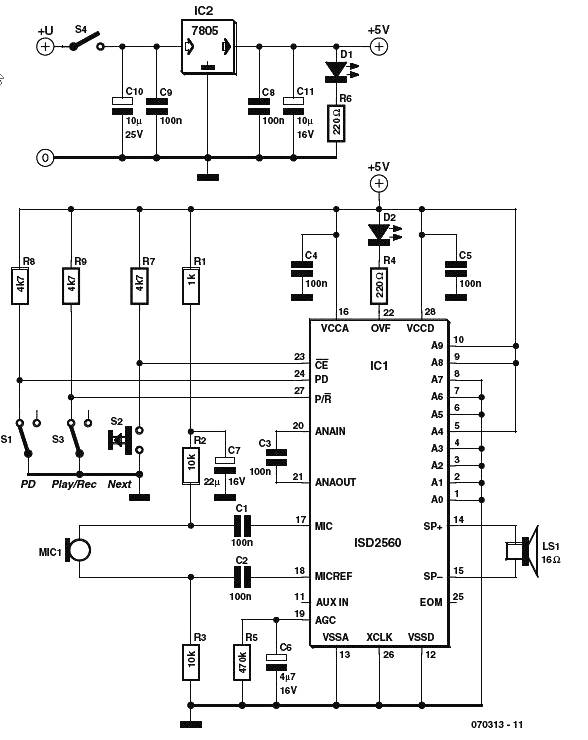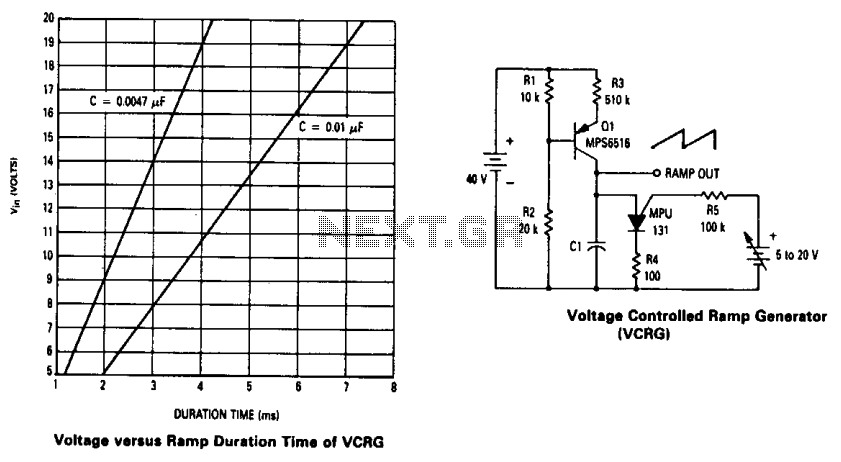
4-Decade Square-Wave Generator
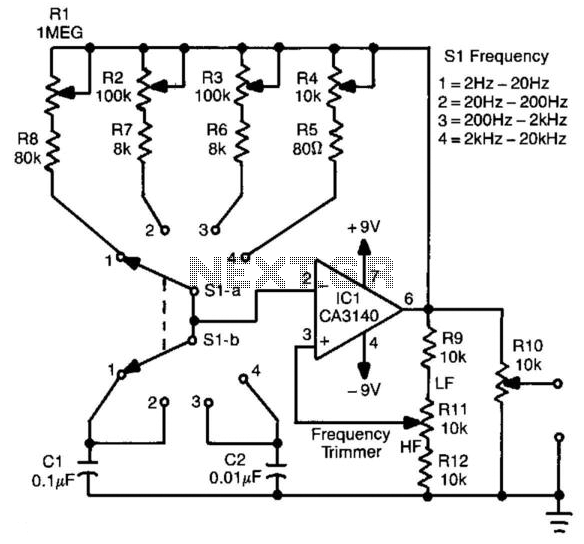
This circuit generates a square wave with a frequency range of 2 Hz to 20 kHz. It employs an operational amplifier in a relaxation oscillator configuration. The output voltage is approximately 15 V peak-to-peak. Resistors R1 through R4 serve as calibration controls for each of the four selectable frequency ranges, determined by switches S1-a and S1-b. Resistor R10 is used to adjust the output level. The frequency selection switch S1 has four settings: 1 = 2 Hz - 20 Hz, 2 = 20 Hz - 200 Hz, 3 = 200 Hz - 2 kHz, and 4 = 2 kHz - 20 kHz.
The circuit is designed to produce a square wave output, which is essential for various applications such as signal testing, waveform generation, and clock pulses in digital circuits. The operational amplifier operates in a feedback loop configuration, allowing it to oscillate and produce the desired frequency output. The relaxation oscillator relies on the charging and discharging of capacitors, which are not explicitly mentioned but are typically integral to such designs.
The calibration controls, R1 to R4, allow for fine-tuning of the frequency ranges, ensuring precise adjustments can be made based on application needs. The frequency selection switches S1-a and S1-b facilitate easy user interaction, enabling quick changes to the desired frequency range without the need for complex adjustments.
Output level adjustment through R10 is crucial for applications requiring specific voltage levels, ensuring compatibility with downstream circuitry. The output characteristics of approximately 15 V peak-to-peak are suitable for driving various loads or for interfacing with other electronic components.
In summary, this circuit provides a versatile solution for generating square wave signals across a wide frequency range, with user-friendly calibration and output level adjustment features, making it suitable for a variety of electronic applications. This circuit will generate a square wave of 2 Hz to 20 kHz. The circuit uses an op amp in a relaxation-oscil lator configuration. The output is about 15 Vpp. Rl through R4 are calibration controls for each of the four frequency ranges, as selected by SI-a and Sl-b. RIO adjusts the output level. S1 Frequency 1= 2Hz - 20Hz 2= 20Hz-200Hz 3= 200Hz - 2kHz 4= 2kHz-20kHz 🔗 External reference
The circuit is designed to produce a square wave output, which is essential for various applications such as signal testing, waveform generation, and clock pulses in digital circuits. The operational amplifier operates in a feedback loop configuration, allowing it to oscillate and produce the desired frequency output. The relaxation oscillator relies on the charging and discharging of capacitors, which are not explicitly mentioned but are typically integral to such designs.
The calibration controls, R1 to R4, allow for fine-tuning of the frequency ranges, ensuring precise adjustments can be made based on application needs. The frequency selection switches S1-a and S1-b facilitate easy user interaction, enabling quick changes to the desired frequency range without the need for complex adjustments.
Output level adjustment through R10 is crucial for applications requiring specific voltage levels, ensuring compatibility with downstream circuitry. The output characteristics of approximately 15 V peak-to-peak are suitable for driving various loads or for interfacing with other electronic components.
In summary, this circuit provides a versatile solution for generating square wave signals across a wide frequency range, with user-friendly calibration and output level adjustment features, making it suitable for a variety of electronic applications. This circuit will generate a square wave of 2 Hz to 20 kHz. The circuit uses an op amp in a relaxation-oscil lator configuration. The output is about 15 Vpp. Rl through R4 are calibration controls for each of the four frequency ranges, as selected by SI-a and Sl-b. RIO adjusts the output level. S1 Frequency 1= 2Hz - 20Hz 2= 20Hz-200Hz 3= 200Hz - 2kHz 4= 2kHz-20kHz 🔗 External reference
